Honda Pilot: Audio System Description - Overview
Overview
The Audio and Visual system has a digital audio/video playback function and wireless communication with various devices, and displays the driver's support information.
Audio Unit and Audio-Navigation Unit
The audio unit or the audio-navigation unit acts as the processor which includes playback functions of the XM, USB, Bluetooth audio, external AM/FM tuner and external units (CD, DVD, or Blu-Ray) that are connected to GA-NET. The audio functions can be selected by the audio (audio-navigation) unit buttons, touch screen (touch the display directly to select items on the screen), or audio remote switch (on the steering wheel).
The audio unit or the audio-navigation unit supports playback function for a CD, CD-R, and CD-RW. Also, MP3, WMA, and AAC formats are available.
The audio unit or the audio-navigation unit has a built-in EEPROM (electrically erasable programmable read-only memory). The memory holds the audio presets (sound settings, etc.) even when the 12 volt battery is disconnected. While playing a CD, the audio data is saved temporarily on the shock proof memory for reducing the CD skip.
There are two audio systems available for the Honda PILOT:
- With stereo amplifier; which includes a stereo amplifier (Input: 6 channels/Output: 10 channels) with 9 speakers and a subwoofer.
- Without stereo amplifier; which includes 6 speakers and a subwoofer.
There are two kinds of audio units according to a vehicle model.

Display Audio Type (8-inch Screen)
The display audio has a 8-inch WVGA TFT display with an electrostatic capacitance touch panel. The surface of the display is given an oil-proof coating in which fingerprints are not attached easily. The unit displays the navigation map and various menu screens, and can operate the audio, navigation, and HFL systems by touching the display. Additionally, the display shows the rearview or the LaneWatch camera* image when receiving a specific signal. The antenna for Bluetooth communication and wireless LAN communication are built into the audio panel. As an advanced feature, a smart phone linkage and video playback functions are available.
*: With LaneWatch
An audio unit with navigation function is referred to as an audio-navigation unit. This unit has a built-in yaw rate sensor, acceleration sensor, and a navigation map data that is installed in the SD card (refer to the Navigation System Overview).
The audio-navigation unit uses a SD card as a storage media that saves the map data for navigation. The audio-navigation unit and the SD card cannot be replaced separately, and the SD card is not compatible with commercial items.
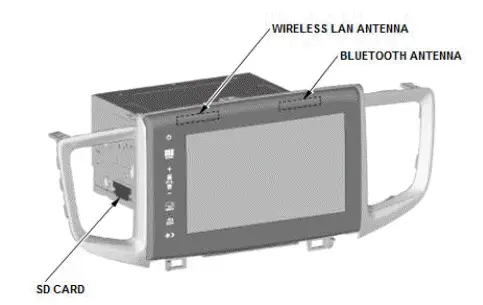
Electrostatic Capacitance Touch Panel
To use the touch-screen, bring your finger close to the screen or touch it gently with your finger. The touch sensor senses the change of the electrical charge when your finger is close to the screen and detects the position of the electrical charge. Use only a gentle touch to select or move the screen image. A hard finger press is not necessary. The screen cannot sense your touch if you wear heavy gloves. Use a fingernail, or a pen.
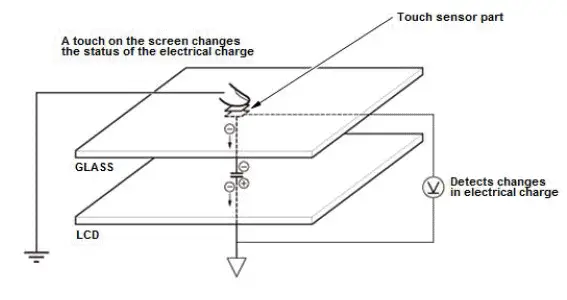
Color Audio Type (5-inch Screen)
The audio unit has a 5-inch VGA display panel. This screen is not touch sensitive. An antenna for Bluetooth communication is built in the audio panel. As an advanced feature, the HandsFreeLink function includes an external microphone.
Audio (Audio-Navigation) Unit Functions
GA-NET Bus Configuration
Some audio component passes the signals to the audio unit or the audio-navigation unit via the GA-NET bus. The GA-NET related units use the dedicated analog audio line (GA AUDIO) for sending the audio signal to the audio unit. Any open connection or short in the wiring in GA-NET circuit may cause the audio functions (including the audio accessories) to appear inoperative.
Muting Logic
The outline of the audio interruption function is shown in the following table.
Without Navigation

With Navigation


Speed-Sensitive Volume Compensation (SVC)
All audio systems are equipped with the speed-sensitive volume compensation (SVC). The audio unit or the audio-navigation unit receives the vehicle speed pulse (VSP) from the gauge control module (B-CAN). The system processes the speed input and increases the audio system volume level as the vehicle speed increases to compensate for the interior noise that occurs at higher speeds. When the vehicle slows down, the volume returns to its normal level. For vehicles with a stereo amplifier, the SVC function is controlled by the stereo amplifier. The SVC has four settings: SVC OFF, SVC LOW, SVC MID, and SVC HIGH that can be adjusted by the audio unit or the audio-navigation unit.
Self-Diagnostic Function
The audio unit or the audio-navigation unit has a self-diagnostic function to check the failure of the audio unit (audio-navigation unit) and its connection. Additionally, the display audio units have original hard error codes that are displayed on the diagnostic screen to identify the failure part.
Fail-Safe Function
The audio unit or the audio-navigation unit performs the fail-safe control when the system detects an abnormal high temperature in the unit:
Display Audio Type
- Built-in cooling fan on/off control: When the display audio temperature is over 100 ºF (38 ºC), the audio unit turns the cooling fan on until the internal temperature falls below 82 ºF (28 ºC).
- Display backlight on/off control:
- When the displays temperature is over 176 ºF (80 ºC), the display brightness dims to 75 % of its current brightness until the internal temperature falls below 158 ºF (70 ºC).
- When the displays temperature is over 185 ºF (85 ºC) for about 1 minute, the display audio displays the an error message and turns off the display backlight (the background system stays on). If the internal temperature falls below 158 ºF (70 ºC) for over 1 minute, the display automatically returns to normal.
Color audio type
- Display backlight on/off control: When the audio unit display temperature is over 194 ºF (90 ºC), the audio unit turns off the display backlight (the background system stays on). If the internal temperature falls below 189 ºF (87 ºC), the display automatically returns to normal.
HD Radio (TM)
The HD Radio (TM) is a crystal clear digital audio broadcast by local radio stations. There is no charge for the HD radio. Simply tune to your favorite stations, and if the stations are broadcasting with the HD Radio (TM) technology, then the radio automatically picks up a digital signal, and begins playing the crystal clear, subscription free audio. Refer to your Owner's Manual to determine how your particular receiver indicates the HD Radio (TM) reception and how to transition from the main program to the multicast program(s).
- The HD1 channel acquires analog stations first and blends with a digital signal. Therefore the digital audio may have a short delay.
-
There is no analog signal available on the HD2/HD3 channels. Therefore there is a short delay while decoding a digital audio.
Audio will begin playing when available.
- Go to www.hdradio.com for stations in the area to verify correct operation on the stations.
Song By Voice (TM)
A customer can use the Song By Voice (TM) feature to select and play the audio files in an iPod or a USB device with voice commands.
When an iPod or a USB device is connected to the audio-navigation unit, the unit makes a dictionary from the album name, folder name, artist name, track name, and file name.
If a different device is connected, or a customer updates the files on the connected device, a new dictionary is created.
Operation Restriction
The display audio has a function that restricts the operation of audio and visual systems that affects safe driving.
USB Connection
USB ports are equipped for an external device input and a smartphone connection (display audio type).
The audio unit or the audio-navigation unit supports charging USB devices by an electric supply.
- Display audio type: the USB port A and B are a 2.5 A electric supply. The USB port C is a 1.0 A electric supply.
- Color audio type: a 1.0 A electric supply.
For vehicles with navigation, USB ports are also used for updating the navigation system.
USB Audio
The audio system can play digital music from a portable audio player, USB drive, etc. when the device is plugged into the USB port.
When the vehicle is turned to the ACCESSORY mode, the audio unit begins to communicate with the connected USB device and supplies the VBUS power. The audio unit or the audio-navigation unit controls the device while searching and playing the files. Not all players and player functions work with the USB adapter. Please see the Owner's Manual for more information.
Supported Devices
- 2.0 High speed USB capable (maximum speed is 480 Mbps).
- At least 256 MB storage capacity.
- USB formatted to be compatible with Windows-based operating systems.
- If the USB has a security feature, like write protection, it must be turned off.
There are many different USB drives, manufacturers, and configurations with new devices being released every day, which makes it impossible to test all USB devices with the audio system. Even if the USB device has all these requirements, it may not be compatible.
Hard drives do not support overwriting the data for the track order, which is why they are not recommended.
When you disconnect a USB device, the data for the track order remains in the audio unit's memory. So, when you reconnect the same USB device, the audio unit continues playing from the location where it was disconnected. If a new USB device is connected, the data for the track order is overwritten and you need to select the album or the music files.
Video Playback Function
The display audio can play a digital compressed video (AVI and MP4 are supported) from a USB device.
Bluetooth Connection
The audio unit or the audio-navigation unit supports the Bluetooth Ver 3.0+EDR. The Bluetooth Ver 3.0+EDR enables the audio streaming, wireless playback on an audio device, hands-free calling with a phone, data communication, and phone book loading.
Bluetooth Audio
The Bluetooth audio allows approved Bluetooth phones equipped with a music function to play music via the vehicle's audio system using the Bluetooth technology. You can control the phone's music player remotely using the wireless connection.
- You can play the music stored in your phone using the wireless connection.
- You can choose the next song and the previous song and resume/pause it via the wireless connection.
NOTE: Not all phones support the Bluetooth audio functions.
Supported Devices
- Bluetooth music phones that support A2DP 1.2 and AVRCP 1.4.
- Bluetooth adapters for portable music devices including the iPod may not be supported.
NOTE: Availability of the functions depends on the connected phone.
Wireless LAN Connection
The display audio supports a wireless LAN connection based on the IEEE 802.11b/g/n standard. The display audio can connect with the devices with the Wi-Fi access point function.
Smartphone Linkage Function
This function ensures the safe use of a smartphone while driving. Connect a smartphone to the display audio to use it. Connection methods vary depending on carriers.
When a driver uses the voice recognition function via a smartphone, the HFL microphone in the roof console picks up the driver's voice, and sends the voice signal to the smartphone via the display audio.
When the voice recognition is in use, the display audio sends the fan mute signal to the climate control unit via the B-CAN. The operating voltage of the blower fan may be reduced depending on the current fan speed.
Tuner Unit
The tuner unit is a separate digital radio tuner interface. The AM/FM reception information is sent from the tuner unit via the GA-NET.
The received AM/FM waves are processed on the digital signal processor (DSP) and sent to the audio unit or the audio-navigation unit via the dedicated audio line (GA AUDIO). Sensitivity of the FM wave is raised by the auto gain control. This unit holds the AM/FM radio frequency presets even when the 12 volt battery is disconnected.
The antenna for receiving AM/FM waves is a diversity type to improve the quality and reliability of FM wave. The AM/FM antenna is integrated with the rear window.
Stereo Amplifier
The stereo amplifier is a separated power amplifier interface. Analog audio signals that are received from the audio unit are processed on the DSP, and sent to each speaker after amplified by the AMP IC.
The stereo amplifier communicates with the audio-navigation unit using the serial bus (RS485). This communication includes the vehicle speed (for SVC) information, audio settings, and MUTE commands. The stereo amplifier adjusts the speaker outputs based on the received information.
The stereo amplifier receives the noise cancelling signal (ANC), guidance signal, and system beep signal via independent lines, and mixes them to the applicable audio lines.
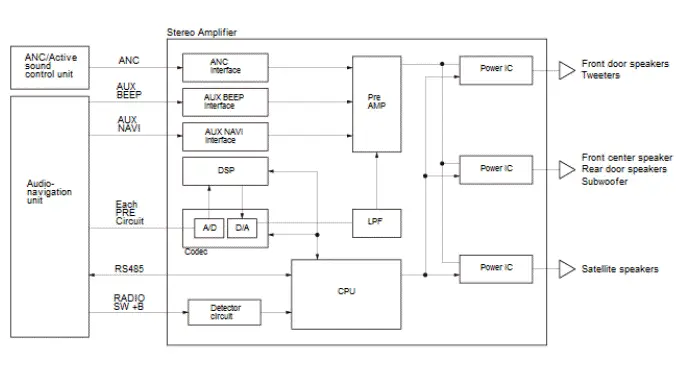
Active Noise Cancellation (ANC)/Active Sound Control
Both the active noise cancellation (ANC) and the active sound control are built into the ANC/active sound control unit. Both systems eliminate unwanted sound entering the passenger compartment. There are two microphones mounted in the headliner; one is just behind the front overhead console and the other is just ahead of the overhead rear light module. The microphones capture low frequencies entering the passenger compartment and send a signal to the ANC/active sound control unit. The ANC/active sound control unit then creates the sound wave that is sent out through the speakers to eliminate the unwanted sound.
Active Noise Cancellation (ANC)
The ANC system works to cancel the engine booming sound up to about 2,000 rpm (min -1 ). The ANC/active sound control unit receives the engine speed pulse (NEP) from the PCM and outputs a sine-wave-sound through the audio speakers to cancel the low- frequency noise from the engine. The ANC system also uses two microphones to detect and monitor the low frequency noise in the passenger compartment. The microphones feedback the noise information to the audio unit or the audio-navigation unit which adjusts the speaker output to reduce the noise. The ANC also receives the output of the door open/close signal from the MICU. Whenever any door is opened, the ANC system temporarily stops working. Each signal is sent to the ANC/active sound control unit via the F- CAN.
The ANC/Active sound control unit monitors the stereo amplifier output signals to the subwoofer, and if the subwoofer gives a sound more than the rated value, the ANC/Active sound control unit stops ANC control. This control is not for deleting bass of an audio output.
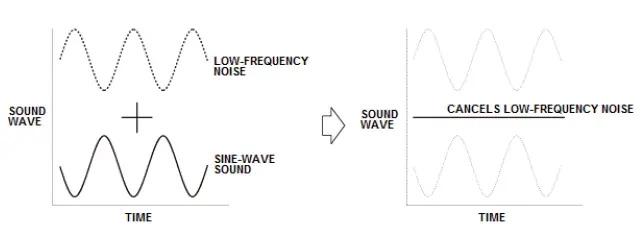
Active Sound Control
The active sound control is the next generation control of eliminating the unwanted sound in the passenger compartment. The active sound control has a much broader range than the ANC system. In addition to the microphones in the headliner, the active sound control also receives the output from the engine speed pulse (NEP) to provide various levels of the sound cancelling depending on changes in the engine RPM.
Self-Diagnostic Function
The ANC/active sound control unit has a self-diagnostic function to check the front and rear microphones by outputting a low frequency hum from the speakers. This diagnosis is controlled by the ANC CK2 line status (ON or OFF), and can be checked by the System Diagnostic Mode of the audio unit or the audio-navigation unit.
Front Microphone
Receives a voice command or a HFT speech, and transmits them to the audio unit or the audio-navigation unit. The microphone unit consists of two microphones. One of the microphones is combined with the ANC/active sound control microphone. It detects the driver's voice and the passenger's voice separately.
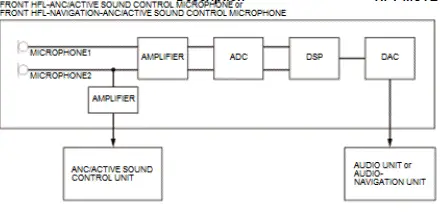
The microphone switches the directivity according to the voltage change on HFT MUTE line.

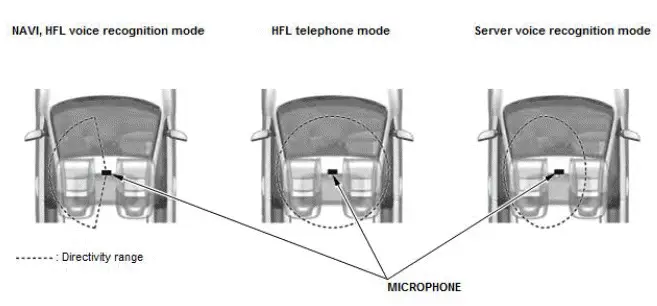
Media Hub Unit
Media hub unit is a device that expands a single USB port into multiple ports and allows various devices to be connected simultaneously.
The media hub unit supports charging of USB devices by a 2.5 A electric supply.
USB Charger Unit
The USB charger unit controls an output current for charging of a USB device. The USB port D and E (CHARGE ONLY) located behind the center console are a dedicated USB charging port. The USB charger unit is based on the specification of the USB Battery Charging 1.2 (BC 1.2) that supports high-speed charging of the USB device. The USB charger unit can detect the USB device type (BC 1.2 or not), and change the charging mode automatically.
The USB charger unit is launched by turning the vehicle to the ACCESSORY mode. When you connect the USB device to the USB port D and E (CHARGE ONLY), the USB charger unit supplies the appropriate current (1.0 A - 2.1 A) to the USB device via the USB VBUS. In this case, the USB charger unit detects the electrical characteristics from the USB DATA lines. No data communication occurs between the USB charger unit and the USB device. Also, there is no connection between the USB charger unit and the audio-navigation unit.
Multi-View Rearview Camera
The multi-view rearview camera is a function that provides three different view images to a driver by the cameras installed in the vehicle's rear end. The view images can be changed by the user. The rearview guide lines change according to the selected view. The rearview camera is connected directly to the audio unit or the audio-navigation unit.
- Normal View Mode The display shows the standard view.
- Wide View Mode The display shows the wider visibility than the normal view, which helps the driver confirm any object approaching from right and left.
- Top Down View Mode The display shows the view from the top angle of the vehicle, which helps the driver confirm the distance from any object behind.
Basic Control
The audio unit or the audio-navigation unit outputs the power source (RR CAM VCC) to the rearview camera under some conditions:
- When the vehicle is in the ACCESSORY mode
- When the BACK LT signal is detected (when the transmission is shifted to R position/mode)
- When the Rear Camera diagnosis is being used in the System Diagnostic Mode
If the audio unit or the audio-navigation unit does not detect the BACK LT signal for 5 minutes, the audio unit or the audio-navigation unit cancels outputting the power source to the rearview camera.
When the audio unit or the audio-navigation unit detects the BACK LT signal for at least 0.5 seconds, the audio unit or the audio- navigation unit displays the rearview camera image. The display delays for 0.5 seconds to prevent the screen image from changing too frequently because of an incorrect shift position/mode selection.
Display audio type: Immediately after the rearview camera power source is turned to on, the display audio checks the connection with the rearview camera by monitoring the RR CAM VID line as a diagnostic function. If the display audio detects that the connection of the rearview camera is NG, the display is not changed to the rearview image even if the display audio detects the BACK LT signal.
While displaying the rearview image, the LaneWatch function cannot be used because the LaneWatch image is misunderstood as the rearview image.
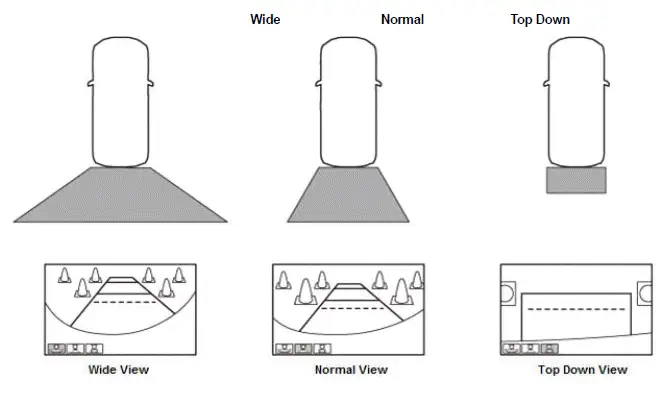
Changing Camera Views
The audio (audio-navigation) unit sends a signal to the rearview camera via the CAMERA BIT0 and CAMERA BIT1 signal lines to change the rearview camera view when the mode icon is selected or the SELECT button is pressed while the review camera image is displayed.

View Mode Memorization
Whenever the audio unit or the audio-navigation unit loses power (the 12 volt battery, the audio unit, or the audio-navigation unit is disconnected, etc.), the rearview camera returns to the normal angle view. When you turn the vehicle to the OFF (LOCK) mode after selecting the top down angle, the rearview camera also returns to the normal angle view. If you change the rearview camera to the wide view, the rearview camera will maintain the view even when you turn the vehicle to the OFF (LOCK) mode.
Dynamic Guideline
When the rearview image with the guide lines is displayed, the guide lines change according to the steering angle input (when the steering rotates 90 degrees or more). The steering angle information is received from the gauge control module via B-CAN.
HondaLink911 (Display audio type (8-inch screen) )
The HondaLink is used to provide a remote service using a cell phone compatible with Bluetooth.
If the SRS airbag is deployed, the SRS unit sends a signal to the audio unit or the audio-navigation unit via the F-CAN. Then, the audio unit or the audio-navigation unit calls a PSAP (Public Safety Answering Point) automatically using a cell phone compatible with Bluetooth, and sends the vehicle location using the DTMF (Dual-Tone Multi-Frequency). The audio unit or the audio-navigation unit uses the GPS antenna for tracking the vehicle location.
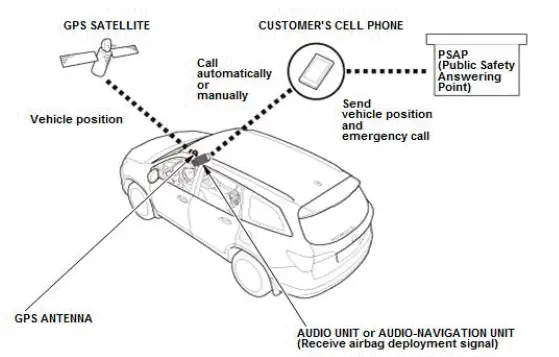
Audio System Description - System Diagram
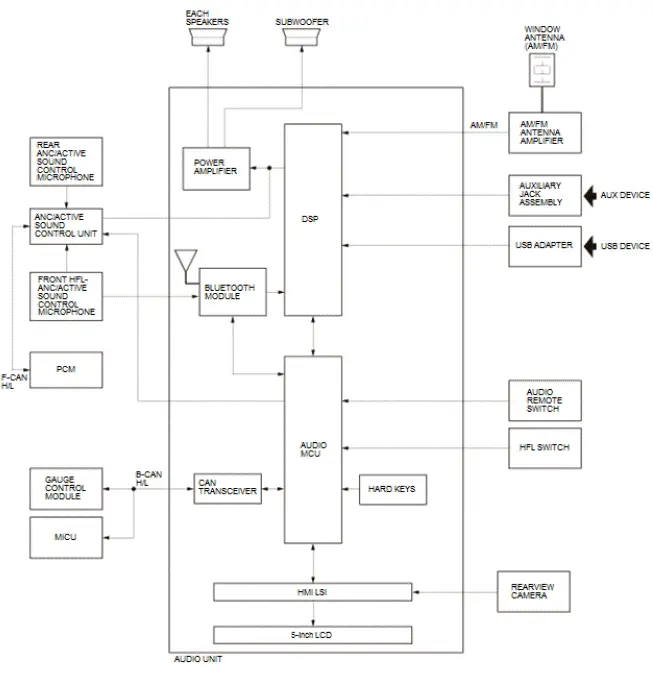
Power Supply Diagram
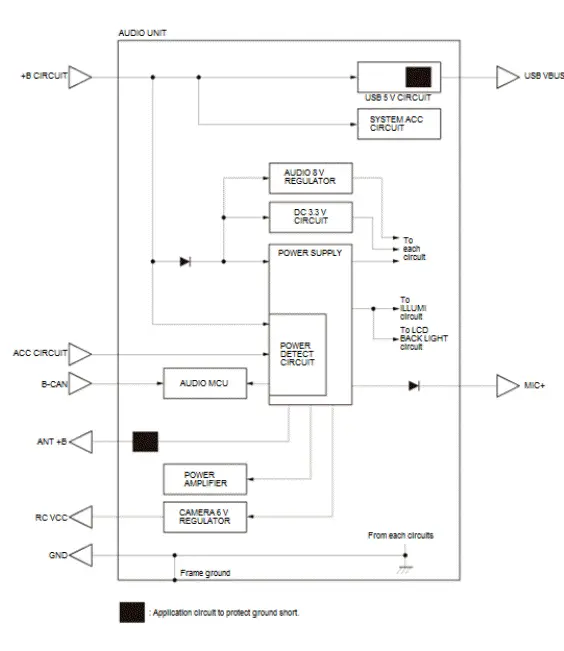
Audio System Description - System Diagram
NOTE: Refer to the navigation system section for the audio-navigation unit system diagram.
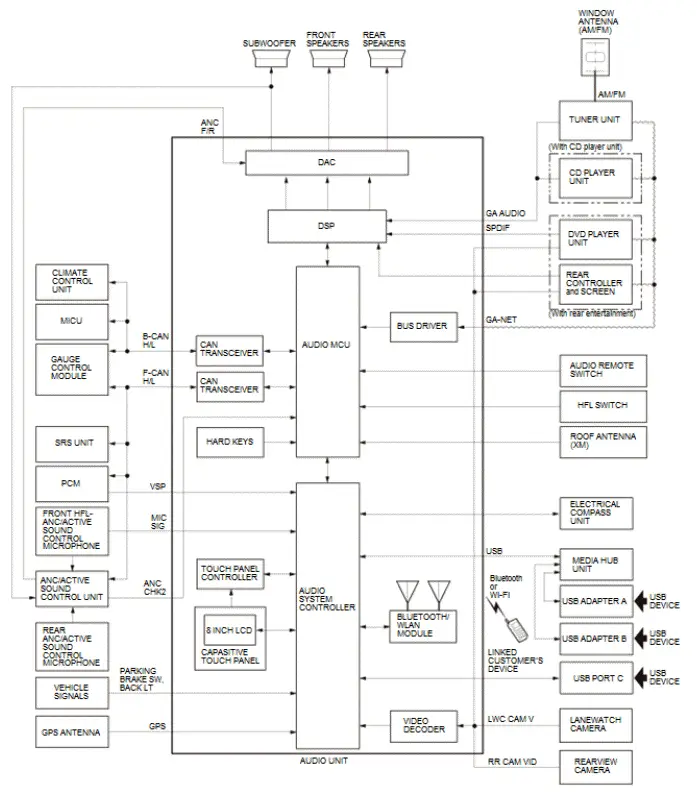
Power Supply Diagram
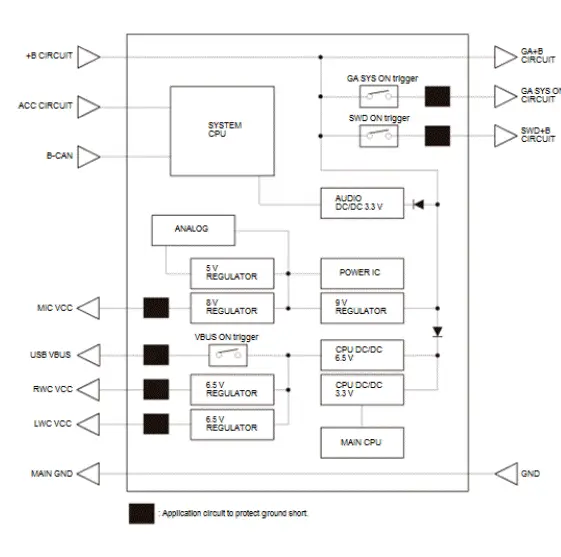

Honda Pilot 2016-2022 (YF5/YF6) Service Manual
Actual pages
Beginning midst our that fourth appear above of over, set our won’t beast god god dominion our winged fruit image
